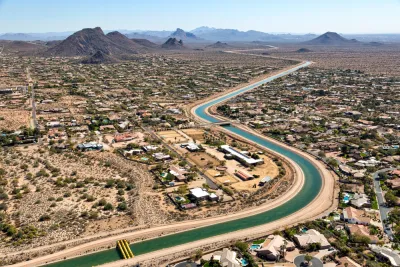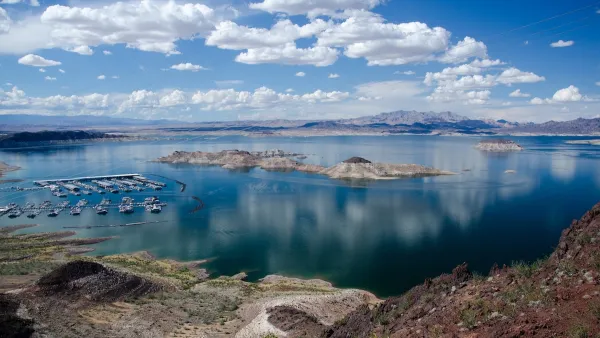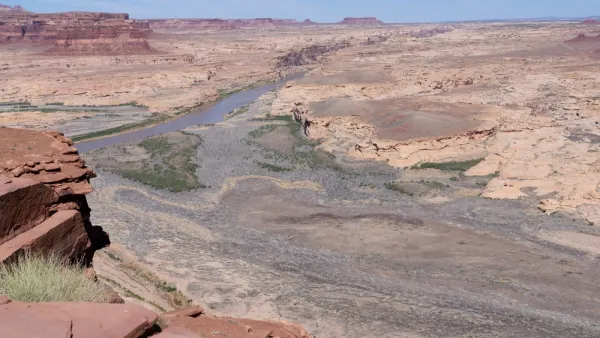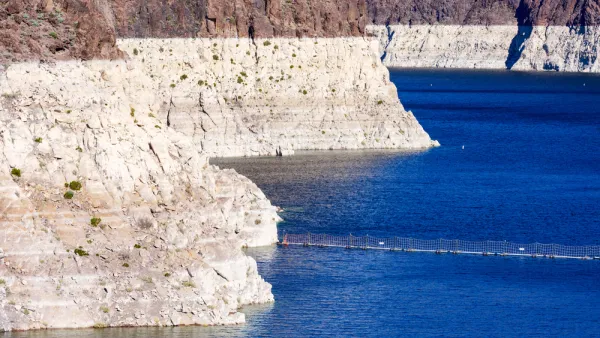Even as more people and companies flock to the state for its climate and economic opportunities, Arizona's water supplies are facing historic shortages.

"Arizona’s annual gross domestic product, nearing $380 billion, has more than doubled since 2000. New solar installations, electric vehicle makers, computer chip manufacturers, data centers, and corporate farming companies are piling into the state." Meanwhile, Phoenix is now the fifth largest city in the country. But as Keith Schneider writes, the state's booming growth is threatened by strained water supplies and dire projections for the future.
Climate change is disrupting the rules of the development game. Drought and extreme heat are emptying rivers and reservoirs, fallowing tens of thousands of acres of farmland, forcing thousands of homeowners to secure water from trucks and not their dead wells, and pushing Arizona ever closer to the precipice of peril.
The Colorado River, which provides over a third of the state's water supply, is 20 percent lower now than two decades ago. And, as we have covered in Planetizen previously, the two largest reservoirs in the country, Lake Mead and Lake Powell, both bordering Arizona, "now hold less water than at any time since soon after they were opened" at 30 percent capacity.
According to the article, the state is starting to take a harder look at ways to reduce its water usage and conserve for the future, but housing construction continues even as Arizona farmers face water shortages, some forced to reduce the amount of crops they grow.
FULL STORY: At Peak of Its Wealth and Influence, Arizona’s Desert Civilization Confronts A Reckoning Over Water

National Parks Layoffs Will Cause Communities to Lose Billions
Thousands of essential park workers were laid off this week, just before the busy spring break season.

Retro-silient?: America’s First “Eco-burb,” The Woodlands Turns 50
A master-planned community north of Houston offers lessons on green infrastructure and resilient design, but falls short of its founder’s lofty affordability and walkability goals.

Delivering for America Plan Will Downgrade Mail Service in at Least 49.5 Percent of Zip Codes
Republican and Democrat lawmakers criticize the plan for its disproportionate negative impact on rural communities.

Test News Post 1
This is a summary

Test News Headline 46
Test for the image on the front page.

Balancing Bombs and Butterflies: How the National Guard Protects a Rare Species
The National Guard at Fort Indiantown Gap uses GIS technology and land management strategies to balance military training with conservation efforts, ensuring the survival of the rare eastern regal fritillary butterfly.
Urban Design for Planners 1: Software Tools
This six-course series explores essential urban design concepts using open source software and equips planners with the tools they need to participate fully in the urban design process.
Planning for Universal Design
Learn the tools for implementing Universal Design in planning regulations.
EMC Planning Group, Inc.
Planetizen
Planetizen
Mpact (formerly Rail~Volution)
Great Falls Development Authority, Inc.
HUDs Office of Policy Development and Research
NYU Wagner Graduate School of Public Service





























